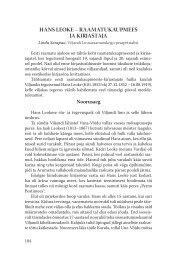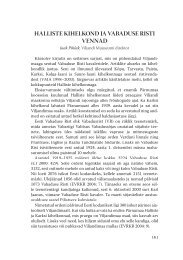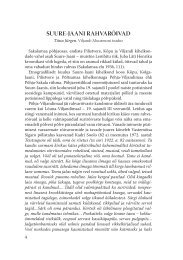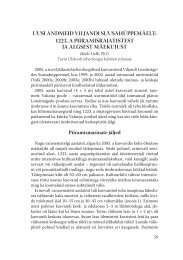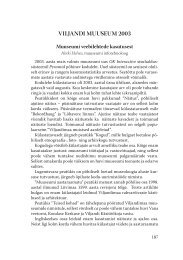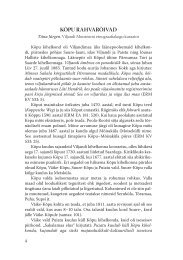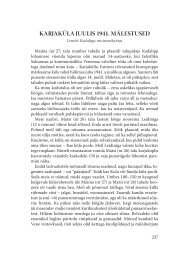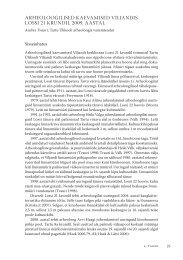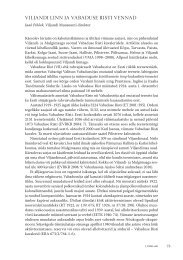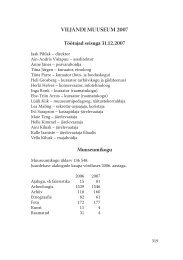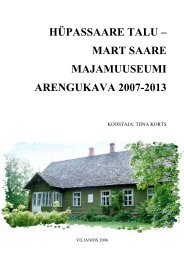NAIVISMI TEINE TULEMINE - Viljandi Muuseum
NAIVISMI TEINE TULEMINE - Viljandi Muuseum
NAIVISMI TEINE TULEMINE - Viljandi Muuseum
- No tags were found...
You also want an ePaper? Increase the reach of your titles
YUMPU automatically turns print PDFs into web optimized ePapers that Google loves.
Naivismi teine tulemine<br />
THE SECOND COMING OF NAIVE ART<br />
Mari Vallikivi<br />
In 2003 the Kondas Centre was opened in <strong>Viljandi</strong>, dedicated to the top<br />
Estonian naïve artist Paul Kondas. Beside varied exhibition policies, the centre’s<br />
priorities include finding the outsiders of the art world, disclosing them<br />
to the public and evaluating.<br />
There are lots of different phenomena beside mainstream art. These are<br />
phenomena that do not easily subject to the analysis and systematisation of<br />
art criticism and these are impossible to define uniformly. While the works<br />
of the “insiders” are generally regarded as belonging to elite art, the works<br />
of outsiders, including the naïve artists, belongs to culture in its broadest<br />
sense. Naïve artists and other self-taught artists have so far always been<br />
described from the position of professional art and obviously one of the<br />
major problems the Kondas Centre has to face will be the wording of the<br />
assessment principles of the “outsiders”. A lot of different terms are used<br />
for phenomena standing outside the institutional art world and it is often<br />
difficult to get oriented in such a terminological mess. The words ‘outsider’<br />
or ‘outsider art’ alone have a wide semantic field. On the one hand it is a<br />
definite art term, which marks the English equivalent of the term art brut<br />
introduced by the French artist Jean Dubbuffet at the end of the 1940s (came<br />
into use as a synonym only in 1972). On the other hand the concept of “outsider<br />
art” has broadened and also become more vague: sometimes the term<br />
is used to denote visionary art, contemporary folk art, marginal art, naïve<br />
art or the creation of other non-professional artists. Thirdly, even a professionally<br />
educated artist who has not succeeded may prove to be an outsider<br />
in the art world.<br />
Discovery of outsider artists and bringing them before the general public<br />
has usually taken place at a time when the professional art has come to a<br />
standstill or is in crisis. So, the naïve artists were discovered at a time when<br />
academic art had fallen into a deep crisis and art brut emerged when avantgarde<br />
art was waiting for the new coming. In Estonia naïve artists became<br />
an issue and they were dealt with institutionally at the beginning of the<br />
1980s. Thereafter and at the time when Estonian professional art attempted<br />
to quickly reach the level of the Western art, naïve art was not dealt with.<br />
Now, at the beginning of the 21 st century, we can speak of the second coming<br />
of the naïve art and the second start of dealing with outsider art in Estonian<br />
art landscape. Professionalism may change in time, but despite the shift of<br />
limits, outsiders do not disappear. Paradoxically, there are more and more<br />
people, who are bored of “professional art” and fascinated by the outsiders’<br />
– often introspective – art.<br />
106




